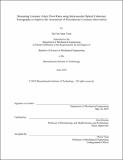| dc.contributor.advisor | Brett Bouma. | en_US |
| dc.contributor.author | Yoon, Ha Yun Anna. | en_US |
| dc.contributor.other | Massachusetts Institute of Technology. Department of Mechanical Engineering. | en_US |
| dc.date.accessioned | 2020-01-08T19:39:16Z | |
| dc.date.available | 2020-01-08T19:39:16Z | |
| dc.date.copyright | 2019 | en_US |
| dc.date.issued | 2019 | en_US |
| dc.identifier.uri | https://hdl.handle.net/1721.1/123377 | |
| dc.description | This electronic version was submitted by the student author. The certified thesis is available in the Institute Archives and Special Collections. | en_US |
| dc.description | Thesis: S.B., Massachusetts Institute of Technology, Department of Mechanical Engineering, 2019 | en_US |
| dc.description | Cataloged from student-submitted PDF version of thesis. | en_US |
| dc.description | Includes bibliographical references (pages 32-33). | en_US |
| dc.description.abstract | In this project, a blood flow quantification technique was developed based on a novel backscattering indicator-dilution approach for intravascular optical coherence tomography (IV-OCT). It achieved the goal of obtaining the flow velocity in a coronary artery of interest by analyzing the backscattering signal from blood after passage of a bolus of Ringer's lactate or another transparent injectate, in parallel to thermodilution coronary flow reserve (CFR). In contrast to thermodilution CFR, the structural OCT image can be used to determine the bolus volume and transit time, as well as used to account for motion and volume change between the two flow readings. More importantly, this technique allows the absolute blood velocities to be determined, providing information that has been challenging to obtain in the past. The experiments conducted using porcine blood in a phantom setup and saline bolus injectate allowed the author to develop an analysis technique to determine transit time, confirming a relation between transit time and flow rate and a relation between the derivative of the transit time and flow rate. Flushing time ([tau]), defined as the time when the normalized flushed area reaches 50%, is inversely proportional to flow rate. Therefore, experimental results validated the feasibility of using OCT to determine transit time of the blood circulation in coronary arteries. Future implication of this experiment is the ability to get more accurate measurement of the blood flow rate at any location regardless of the blood vessel geometry. Findings of this and future experiments can be used to implement intravenous OCT flowmetry for clinical use in diagnosing cardiovascular diseases. | en_US |
| dc.description.statementofresponsibility | by Ha Yun Anna Yoon. | en_US |
| dc.format.extent | 33 pages | en_US |
| dc.language.iso | eng | en_US |
| dc.publisher | Massachusetts Institute of Technology | en_US |
| dc.rights | MIT theses are protected by copyright. They may be viewed, downloaded, or printed from this source but further reproduction or distribution in any format is prohibited without written permission. | en_US |
| dc.rights.uri | http://dspace.mit.edu/handle/1721.1/7582 | en_US |
| dc.subject | Mechanical Engineering. | en_US |
| dc.title | Measuring coronary artery flow rates using intravascular optical coherence tomography to improve the assessment of percutaneous coronary intervention | en_US |
| dc.type | Thesis | en_US |
| dc.description.degree | S.B. | en_US |
| dc.contributor.department | Massachusetts Institute of Technology. Department of Mechanical Engineering | en_US |
| dc.identifier.oclc | 1135062757 | en_US |
| dc.description.collection | S.B. Massachusetts Institute of Technology, Department of Mechanical Engineering | en_US |
| dspace.imported | 2020-01-08T19:39:13Z | en_US |
| mit.thesis.degree | Bachelor | en_US |
| mit.thesis.department | MechE | en_US |
